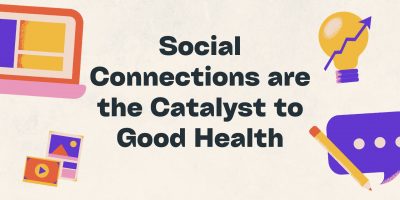
Social Connections are the Catalyst to Good Health
Unlock the secret to a longer, healthier, and happier life: It’s not just about steps and veggies, it’s about the power of meaningful social connections.


CEO and Founder of Breadnbeyond

Co-Founder of Milkwhale

Digital Marketing Manager of Explainerd
Since they have been around, employee benefits have gained more and more ground. Nowadays, they are vital for every company considering that 92% of employees state that benefits are essential for their overall work satisfaction.
Therefore, it is no surprise that 72% of employers plan to personalize their benefits packages, with 75% putting employee experience at the epicenter of the transformation.
However, the levels of benefits literacy among workers are pretty low.
The “MyChoice Recommendation: Engine Benefits Insights” report shows that two-thirds of employees are confused about their benefits package. The lack of comprehension is most prevalent among the Gen Z demographic.
In fact, the same report states that barely one in five workers claim they profoundly understand their benefits plans.
Likewise, according to the “Thomsons Online Benefits’ Global Employee Benefits Watch” whitepaper, over half of employees state they do not have the option to access benefits in a preferred way, and merely 21% report having easy access to their benefits.
Hence, to help employees understand their benefits and learn how to access them easier, Shortlister collaborated with experts who offered their opinions and advice on the matter.
Employee benefits can be any tangible or nontangible non-pay compensations granted to employees, either mandatory by law or voluntarily provided by the company.
Simply put, anything workers receive from their employer over their initial salaries can be a benefit.
Companies must provide a handful of state-mandatory benefits.
Aside from the compulsory benefits, organizations can also implement additional perks or fringe benefits.
Most frequently, employers provide employees’ benefits organized as packages or programs incorporating more than a few alternatives.
Comprehensible employee benefits packages include various options, from health insurance, profit sharing, and 401(k) plans to training opportunities or stock options.
It is up to the company to decide what to implement, but certain benefits are mandatory by law. However, since required benefits vary from state to state, the U.S. Department of Labor advises that employers contact their local state’s Department of Labor offices to check the correct requirements.
The following benefits are obligatory for almost every business in the U.S., but keep in mind that, as with any rule, there may be exceptions.
Additionally, companies that have 50 employees and more are also required to cover:

No matter what a company offers, benefits coverage can favor both the personnel and the employers for several reasons.
First, they are the perfect initiative to improve workers’ focus and productivity. In fact, 51% of employees agree that benefits affect their work efficiency.
Secondly, benefits can greatly influence attraction and retention.
A Glassdoor study shows that 63% of job seekers look at the company’s benefits when considering a job. Additionally, workers say they are 1.6 times more likely to stay loyal to an organization if they are happy with their benefits package.
Lastly, companies that use benefits as a strategic tool report 58% better company performance compared to the 34% among businesses that don’t have a strategic approach to benefits.
Employee benefits programs, otherwise known as packages or plans, are a set of benefits companies provide for their workers. Usually, they are paid for entirely or in part by the employer.
Apart from the law-obliged benefits, the plans may also have further perks. Typically, the additional options can be divided into four major categories:
1) Medical Insurance
Medical insurance is the most common additional benefit selection.
BLS statistics show that in March 2021, medical care was available to 71% of workers in the private industry and 89% of employees in local and state governments.
Medical insurance is an umbrella term that includes healthcare, vision, and dental insurance. There is no general standard medical insurance, but the offerings differ from provider to provider.
2) Life Insurance
Employers often incorporate life insurance in their packages to protect their workforce. The Insurance Barometer study reported that 57% of employees had life insurance in 2021. There are several types of life insurance: group term, group accidental death, business travel accident, and split-dollar life insurance.
3) Retirement Benefits
Many companies provide employees with the possibility to save for retirement.
Usually, they put forward two methods: a 401(k) plan or a pension plan. The two differ in who provides the funds. Workers contribute towards a 401(k) plan, and employers may or may not make matching contributions. Employers guarantee and fund a specific amount towards an employee’s pension plan.
A CRS report shows that in March 2021, 72% of civilian workers, 68% of private sector employees, and 92% of state or local government personnel had access to retirement benefits.
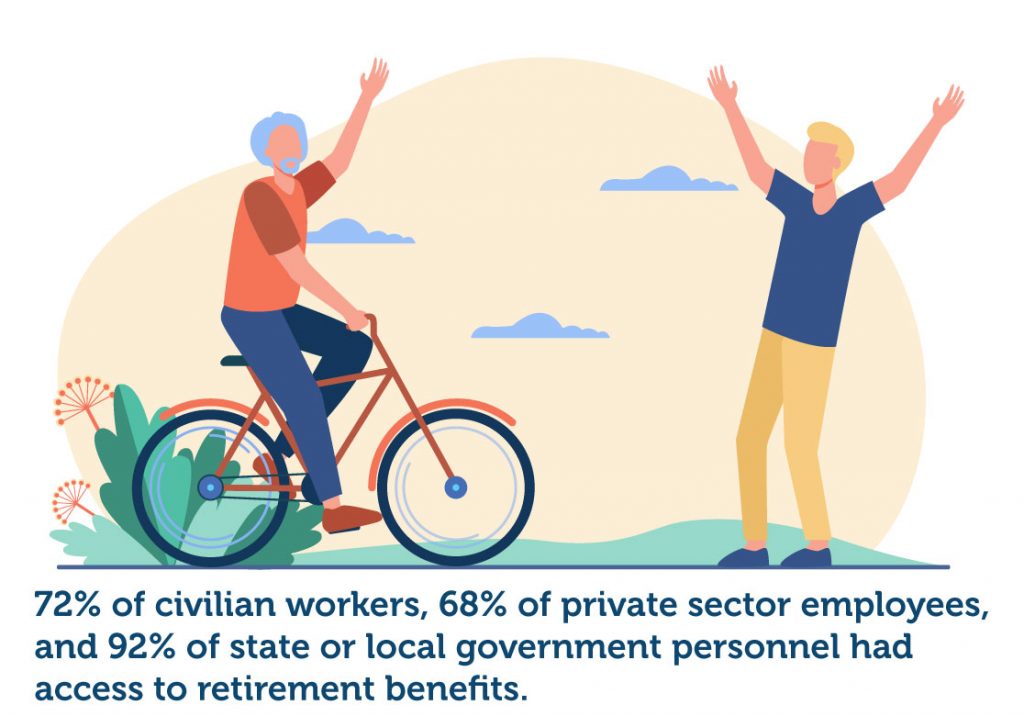
4) Disability Insurance
There are two types of disability insurance: short-term and long-term, differing in the length of coverage.
Disability benefits are not federally required. However, five states – California, Hawaii, New Jersey, New York, Rhode Island, and Puerto Rico – have mandatory disability insurance requirements.
According to the BLS, 40% of employees had access to short-term and 35% to long-term disability insurance in 2020.
Aside from these most common categories of additional benefits, employers can also incorporate fringe benefits into the plans. These include options like wellness programs, educational costs, remote worker’s perks, or commuter benefits.
Typically, companies provide fringe benefits to stand out from the competition and to implement a package with a more holistic approach.
Sometimes additional fringe benefits become part of the package depending on the business type and the job position. For instance, if the job requires commuting to do the work, the company might offer the employee the benefit of using a company car.
But today, more than half of the workforce wants to design their benefits package.
As a result, employers offer flexible benefits plans that allow workers to decide on additional benefits instead of creating an umbrella plan for the entire personnel.
Since fringe benefits are included in a worker’s gross income, they are taxable.
Therefore, it is vital that employers carefully consider how they design the benefits package to ensure it fits the employees’ needs and the employers’ budgets and objectives.
The SHRM provides a detailed guide on the advisable steps when designing an employee benefits program.
1) Determining the Company’s Benefits Budget & Goals
The main factors when identifying the benefits’ goals are the company’s size, location, and industry. Depending on them, the business should decide whether the objectives will be general or employee-specific.
Once the goals are known, they can serve as a guideline for developing a list of benefits that will meet the workers’ and the organizations’ needs.
Another essential step during the first phase is determining the budget since companies often have cost restraints. The cost of benefits can fluctuate, so it is crucial to define the initial and projected costs.
2) Carrying Out a Needs Analysis
Determining employees’ needs is another vital step in designing the perfect benefits package. The best approach to do this is to ask employees. A company can conduct employee interviews or ask workers to fill out questionnaires.
Moreover, considering the demographics of the workforce is another vital element, as younger employees have different needs compared to older ones.
3) Devising a Benefits Plan Program
Once the analysis is done, the next step is to devise a benefits plan program.
The employer can start developing its package and determine the costs using the information gathered.
This is when the organization should reflect upon all the different factors, such as whether the costs can be reduced, who will administer the benefits, do the benefits bring value to the workers, and other vital considerations.
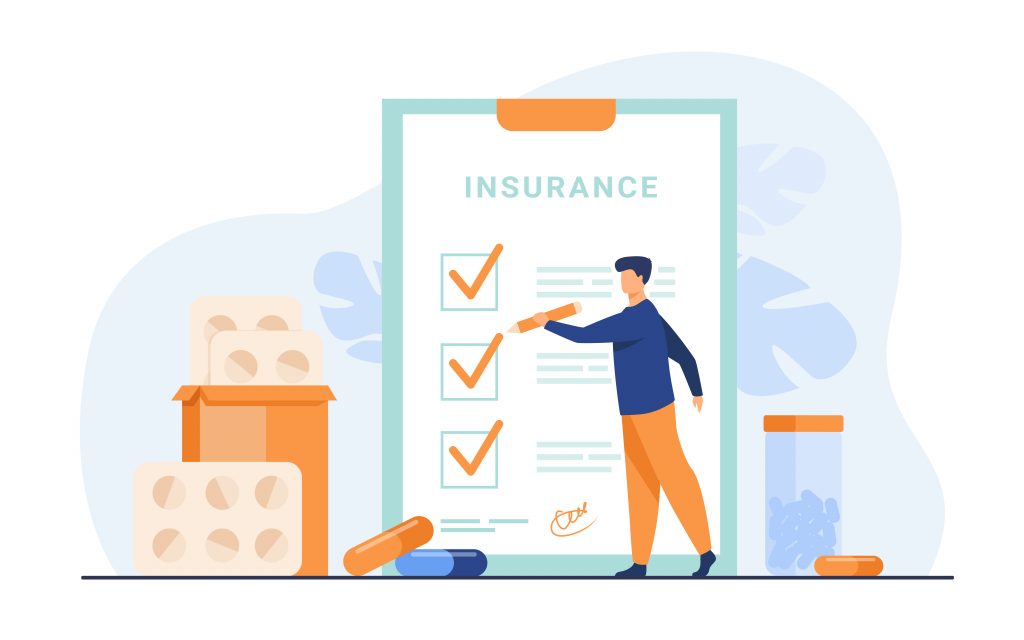
4) Presenting the Benefits Plan to the Workforce
It is imperative to communicate the benefits package to the employees.
Without having employees’ support, no matter how well designed the plan is, it may end up being fruitless.
Even though companies legally must communicate their benefits to their personnel, communication should extend beyond legal obligations.
Employers should raise awareness of the importance of benefits for their workers, ensure that their staff understands the packages, facilitate accessibility, and encourage their employees to use them.
CEO & Founder of Breadnbeyond, Andre Oentoro, provided a few ways employers can provide easy access to benefits for their workers.
“The most common method is through an employee handbook or manual.
Some employers may choose to distribute information through an online portal to help employees view their coverage, check claim status, and find contact information for their carriers.
Other employers opt to hold regular meetings or seminars to discuss benefits and updates.”
5) Designing an Evaluation Process to Establish the Program’s Effectiveness
Every company should have an evaluation process to determine whether the benefits packages align with the company’s objectives and employees’ needs.
Based on the assessment, the program should go through changes if necessary.
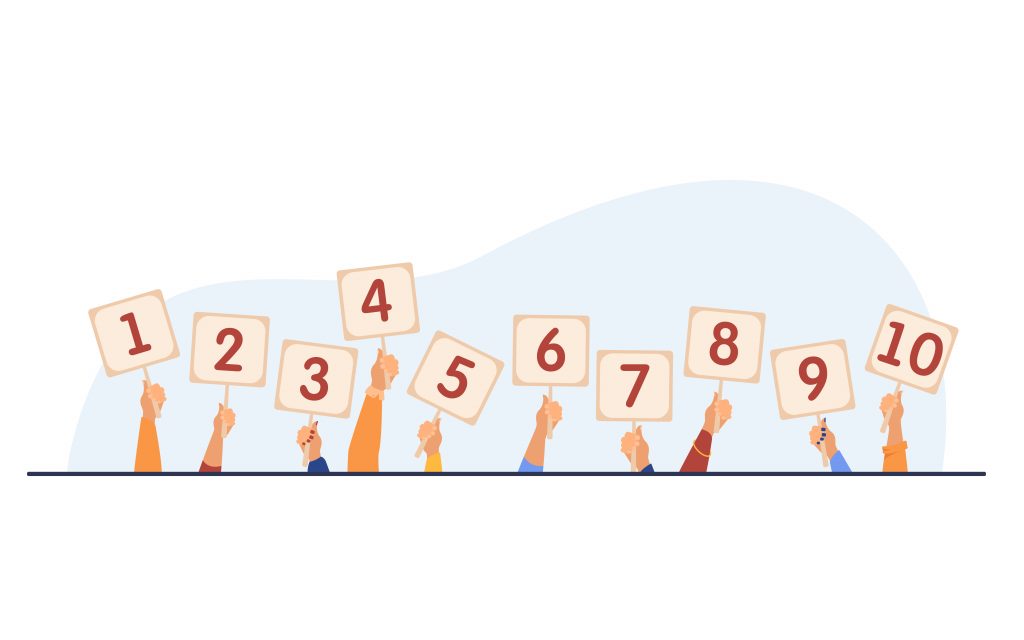
The pandemic has completely changed the current benefits landscape.
What was considered crucial some years ago is now replaced with flexible benefits plans workers design themselves.
As a result, certain benefits that bring more value to the employees are becoming more popular nowadays.
1) Flexible Working Arrangements
Among the top three reasons workers are on the hunt for a new job is the possibility of flexible working. In fact, almost 30% of people left their jobs without having found another one due to a lack of workplace flexibility.
2) Remote Work
Due to COVID-19, many people had to move out of the office and work from home.
As a result, nearly half of the workforce currently wants to work remotely. Luckily, companies are keeping up with this trend; today, 58% of people can work remotely for at least part of the week.
3) Paid Time Off
Work-life balance is becoming increasingly important for workers in today’s ever-changing working environment. A QuickBooks Time survey found that most employees receive paid time off, but 31% don’t receive any.
Nonetheless, companies should be mindful that one-third of the workforce deem work-life balance as the most important of all benefits.
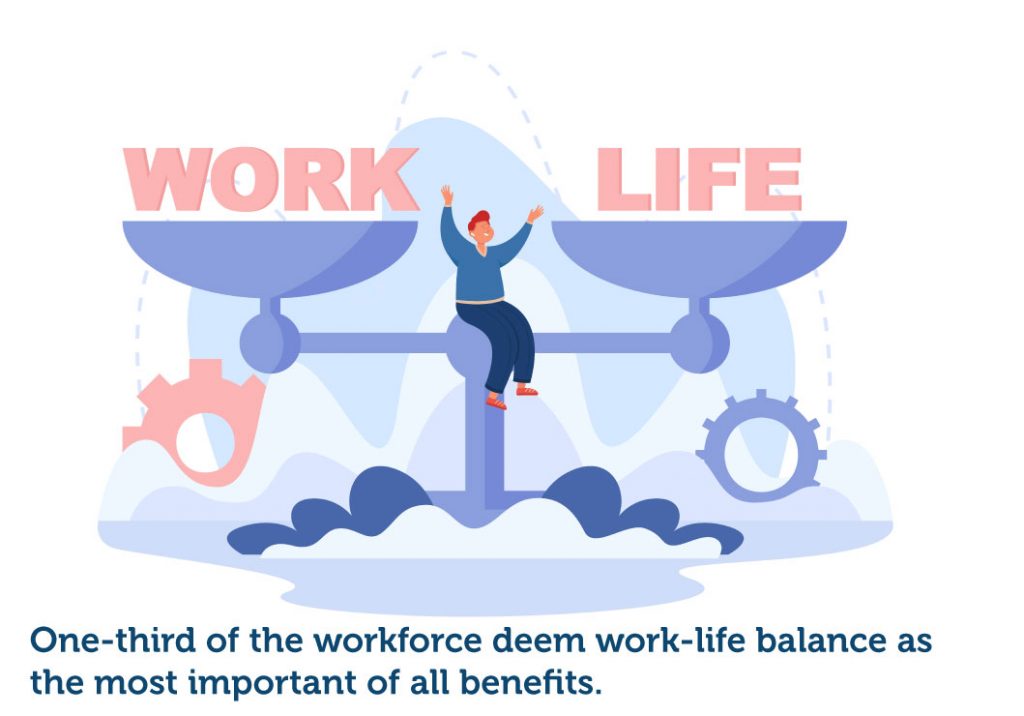
4) Child Care Benefits
Due to the COVID-19 outbreak, many parents had to stay home to look after their children, resulting in 57.1 million losing their jobs. Thus, 81% of working parents are now putting child care benefits as a top priority in their benefits packages.
5) Mental Health Benefits
Mental health in the workplace is currently a hot topic.
America’s Mental Health study shows that 75% of Americans consider their mental health to be just as important as their physical health.
However, the same survey shows that 29% of people didn’t know how and where to seek mental health treatment, and 42% couldn’t afford it. Hence, offering mental health benefits can go a long way in helping employees with their mental well-being.
Often, employees cannot access their benefits because they can’t comprehend what they are and how they can utilize them.
The International Foundation of Employee Benefits Plans’ Benefits Communication Survey Results shows that nearly two in five organizations have a budget devoted to promoting and communicating benefits to their workers.
Yet, 19% of companies report that their workers do not understand their benefits because 80% of employers believe they don’t read the materials.
Nonetheless, Businesslover’s 2022 Benefits Insights Report found that, on average, 86% of employees are confused by their benefits.
This shows that both parties, the employers and the employees, must work on better employee benefits access.
On the one hand, employees should make more significant efforts to familiarize themselves with the options they have at hand.
Natasha Rei, digital marketing manager of Explainerd, offered her advice on how workers can check what is available.
“First and foremost, check with your Human Resources department to see what is available to you. Many companies offer great benefits packages that include health insurance, 401k plans, and more.
If your company does not offer benefits, or if you’re unsure of what’s available to you, there are a few other resources you can check.
The first is the state government’s website. Each state’s website should have information on employee benefits, including health insurance and other types of coverage.
Another great resource is the United States Department of Labor’s website. This site has a wealth of information on employee benefits, including links to state-specific resources.”
On the other hand, companies should ensure that their workforce understands and is taking advantage of the benefits. Organizations can achieve this through several methods that facilitate easy access to benefits.
1) Utilizing Technology
Some companies turn to employee benefits platforms to improve the employee benefits experience. Such platforms integrate all services in one place so workers can easily understand and access their packages.
In fact, 90% of companies using software say it has a crucial role in enabling them to respond quickly to changes in their benefits strategy.
2) Making Open Enrollment an Everlasting Process
Organizations dedicate a particular time of the year when employees can choose or renew benefits. However, this doesn’t mean that those set periods are the only time when employers should check with their workers regarding their packages.
Instead, employers and employees will be better off if they gain knowledge and receive guidance on benefit selection and utilization throughout the year. Ease’s 2022 Open Enrollment Readiness Report shows that 94% of organizations believe they need ongoing consultation from their brokers year-round.
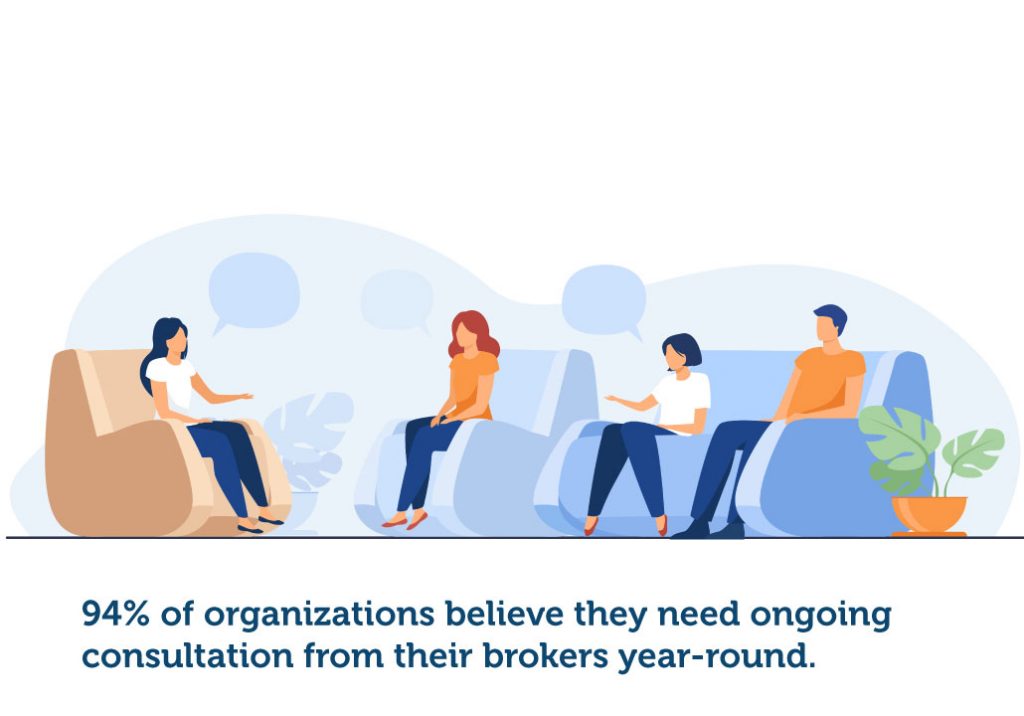
3) Choosing the Right Provider
According to a Gallagher survey, 38% of organizations (53% of large companies) rely on vendors for external support.
Thus, it is of vital importance to choose the best provider possible, especially regarding assistance. Frequently, many carriers’ call centers or websites are not responsive or helpful. Therefore, companies should focus on selecting a vendor with a dedicated team to conduct open enrollment and provide consistent support and assistance.
In today’s new era of technology, many HR professionals and recruiters rely on benefits administration solutions to assist them with administrating the benefits programs during the onboarding process. However, even though the procedures are rigorous, people may still make mistakes.
This is where employee benefits liability insurance can come in handy. But what does employee benefits liability coverage exactly mean?
Employee benefits liability (EBL) coverage is a type of insurance that helps with risk management. Essentially, it protects businesses against possible errors, omissions, or negligence while administrating employee benefits programs.
For instance, suppose an HR manager fails to enroll a new employee in the company’s health plan. There comes a time when the employee needs health insurance only to find out they don’t have one.
In a situation like this, the worker might decide to sue the company for negligence, but the EBL insurance can help financially cover the company.
The EBL insurance policy protects companies with regard to several benefits plans:
Small businesses don’t have large budgets at their disposal.
Therefore, they have to get creative with their benefits offerings. However, if the benefits keep the employees’ needs and values in mind, they can still achieve great results.
Even in a small business, accessing benefits can be confusing for workers. Hence, as co-founder of Milkwhale, Ebnu Sudarso, said,

If employers can do that, they can provide many widespread low-cost benefits to improve the attraction and retention of their workforce.
1) Employee Rewards & Recognitions
People love being recognized for their hard work, even if the reward is cost-effective, like a gift card or a discount. It is still a great initiative for a business to show that it values high-performers.
In fact, 44% of workers prefer a gift card as a recognition reward.
2) Wellness Programs
Besides improving employees’ fitness and overall health, wellness programs can foster teamwork among colleagues. Such programs don’t even have to cost a fortune. For instance, WellSteps offer a wellness program using a proprietary wellness platform that costs between $36 to 90$ per employee annually.
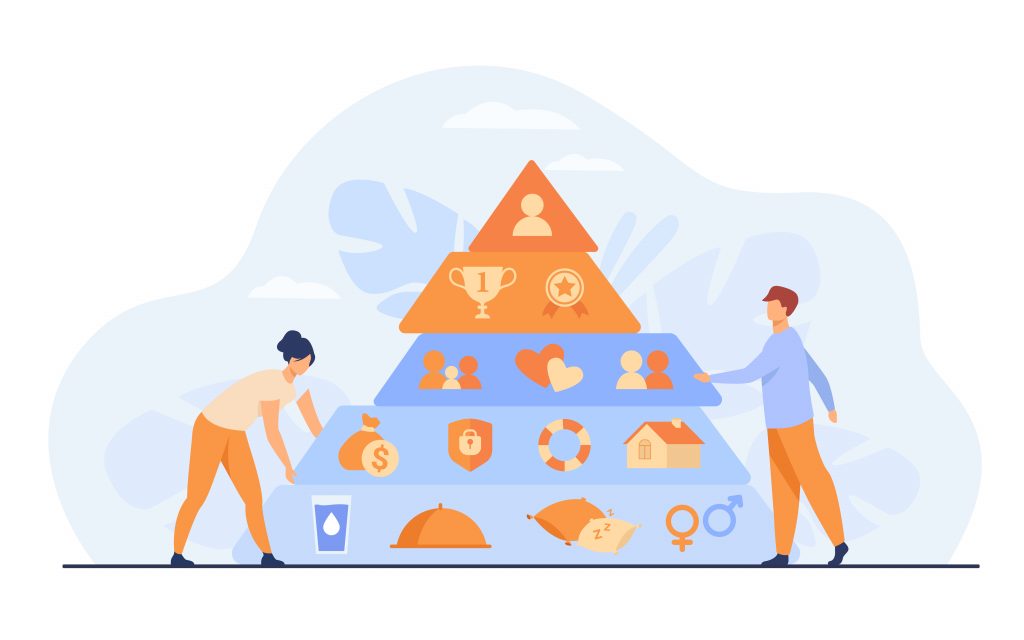
3) Retirement Benefits
A 2022 Global Benefits Attitudes Survey reports that 44% of workers consider a retirement plan crucial for joining a company, whereas 60% see it as a reason to stay.
If matching employee contributions towards a retirement plan is too much of a financial burden for a small business, simply offering the mechanism for workers to contribute on their own can be of great value to them.
4) Stock Options or Equity
Offering stock options or equity is a cost-effective way of attracting and retaining employees. If they feel like they own a part of the company, they will be more inclined to be more productive and stay loyal.
5) Paid Vacation Time
For 45% of employees, paid vacation is the second most important benefit after health care. Research shows that people encouraged to take vacation days are much happier with their jobs. In addition, 78% of leaders report that vacation improves employees’ focus, and 81% state that it relieves burnout.
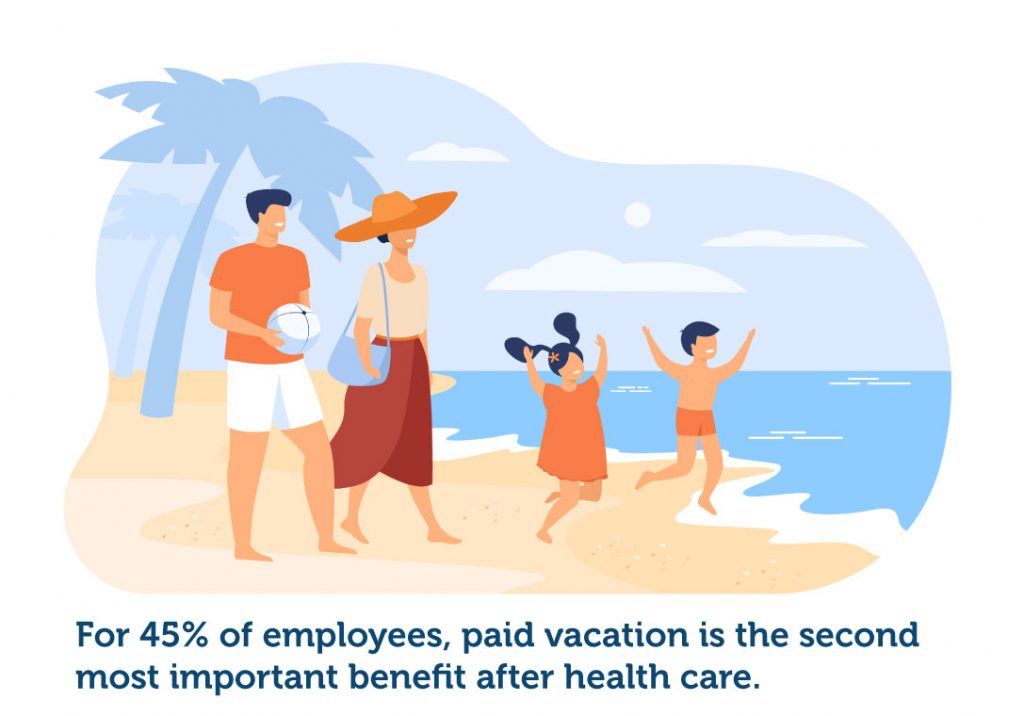
Getting the word out about benefits might not be straightforward since no single way can do the trick.
As Ebnu Sudarso said, “every employee has the right to know what their benefits are and how they can access them.
So, a simple guide or list of questions at the beginning of an employee’s tenure should be given to get a rough idea of what the benefits entail. They should also be mentioned during the interview or onboarding process to avoid any confusion in the future. ‘”
However, in addition to the more traditional approaches to promoting benefits, employers can also use diverse strategies to encourage their workforce to get acquainted with and utilize their packages.
1) Dedicated Website
Grouping all benefits into one place, as Salesforce has done, is a perfect way to provide a detailed, all-inclusive guide for all benefits in the package. An accessible and easy-to-use website will engage workers with benefits, minimize frustration, and enhance the experience.
2) Monthly Newsletters
Another approach is to send employees a monthly newsletter containing tips on utilizing their benefits better. The newsletter can also include an article on health and wellness, as well as other topics and the company’s benefits options connected to them.
3) New Hire Orientation
It is beneficial to present and explain the offerings to workers when they are new to the company. The HR department can also provide them with a binder containing information in detail.
4) Transparent documents
Some employees want to know everything about the benefits they are offered. That is why certain companies, such as AARP, take a total transparency approach, providing documents that explain even the most minor details about the benefits.
5) Messaging channels
Companies can encourage the workforce to share their experience utilizing benefits through a messaging channel. This is a great way to promote the packages and help the workforce understand how they can take advantage of them.
Offering employee benefits is an essential strategy in attracting and retaining workers since one-third of them find them extremely important when choosing a job.
However, since employees sometimes lack understanding of their benefits packages and aren’t sure how to access them, it is even more critical to ensure they comprehend and know how to utilize their packages.
Browse our curated list of vendors to find the best solution for your needs.
Subscribe to our newsletter for the latest trends, expert tips, and workplace insights!

Unlock the secret to a longer, healthier, and happier life: It’s not just about steps and veggies, it’s about the power of meaningful social connections.
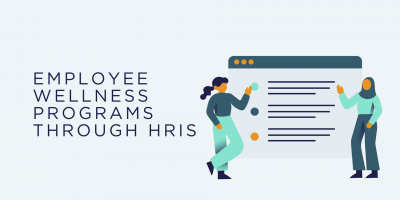
In the intersection of HR technology and employee wellness programs, companies have found ways to maximize their benefits and those of their employees.

Address workplace stress head-on with practical solutions to encourage a healthier, more productive work environment.

Dive into the latest sleep statistics and uncover the impact of quality sleep on wellness, mental health, and daily functioning.
Shortlister Connect is a tool specifically designed to be utilized by the HR and Procurement/Sourcing teams within mid-size, large and jumbo employers. Shortlister Connect allows these teams to efficiently research & identify their optimal vendor partners, track existing vendor relationships & performance and “connect” with other employers to share successes and vendor experiences.
If you are not on the HR or Procurement/Sourcing team within an employer with over 200 employees, you will not be granted access to Connect. Examples of individuals that would not be granted access include, but are not limited to: vendors, students, practitioners, researchers, other non-employers or anyone that is unwilling to identify themselves will not pass our vetting criteria. If you are a consultant, Shortlister offers a specialized product for consultants, called Shortlister Select. You can email Tom Ciccotti at tciccotti@myshortlister.com to learn more about Shortlister Select.
***Shortlister retains the exclusive right to grant or deny access to any party to ensure the privacy of the vendors in our system.
Please login with your LinkedIn Credentials
Used by most of the top employee benefits consultants in the US, Shortlister is where you can find, research and select HR and benefits vendors for your clients.
Shortlister helps you reach your ideal prospects. Claim your free account to control your message and receive employer, consultant and health plan leads.